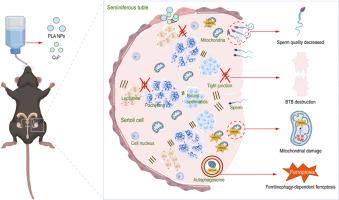对男性生殖毒性的新见解:由聚乳酸纳米塑料和硫酸铜引发的自噬依赖性铁下垂
IF 5.4
2区 医学
Q1 BIOCHEMISTRY & MOLECULAR BIOLOGY
引用次数: 0
摘要
聚乳酸(PLA)塑料以其安全性和生物相容性被广泛应用于包装领域。然而,聚乳酸可以产生微/纳米塑料(MNPs),这些微/纳米塑料通过吸附自然环境中的铜(Cu)等重金属,渗透到食物链中,对健康构成威胁。本研究探讨了自噬依赖性铁下垂在PLA NPs和cu诱导的睾丸损伤中的作用。C57BL/6J小鼠口服100 nm PLA NPs和硫酸铜(CuSO4) 4周。这种综合暴露造成了严重的生殖毒性,包括精子数量和活力减少,精子变形增加,血睾丸屏障受损,性激素水平紊乱。机制上,PLA NPs和CuSO4触发氧化应激和铁蛋白自噬,导致睾丸组织铁超载和铁下垂。使用铁下垂和自噬抑制剂证实了这一途径的关键参与,这减轻了睾丸损伤。这些发现提供了生物基PLA NPs和Cu共暴露诱导生殖毒性的第一个证据,突出了自噬依赖性铁凋亡在睾丸损伤中的重要作用,并为纳米颗粒和环境污染物的联合毒理学效应提供了新的见解。本文章由计算机程序翻译,如有差异,请以英文原文为准。

Novel insights into male reproductive toxicity: autophagy-dependent ferroptosis triggered by polylactic acid nanoplastics and copper sulfate
Polylactic acid (PLA) plastics are widely used in packaging for their safety and biocompatibility. However, PLA can generate micro/nanoplastics (MNPs), which infiltrate the food chain and pose health risks by adsorbing heavy metals such as copper (Cu) from the natural environment. This study investigated the role of autophagy-dependent ferroptosis in PLA NPs and Cu-induced testicular injury. C57BL/6J mice were orally exposed to 100 nm PLA NPs and copper sulfate (CuSO4) for 4 weeks. The combined exposure caused significant reproductive toxicity, including reduced sperm counts and motility, increased sperm deformation, damaged blood-testis barrier, and disrupted sex hormone levels. Mechanistically, PLA NPs and CuSO4 triggered oxidative stress and ferritinophagy, leading to iron overload and ferroptosis in testicular tissue. The critical involvement of this pathway was confirmed using ferroptosis and autophagy inhibitors, which mitigated testicular injury. These findings provide the first evidence of reproductive toxicity induced by bio-based PLA NPs and Cu co-exposure, highlighting the vital role of autophagy-dependent ferroptosis in testicular injury and offering new insights into the combined toxicological effects of nanoparticles and environmental pollutants.
求助全文
通过发布文献求助,成功后即可免费获取论文全文。
去求助
来源期刊
CiteScore
7.70
自引率
3.90%
发文量
410
审稿时长
36 days
期刊介绍:
Chemico-Biological Interactions publishes research reports and review articles that examine the molecular, cellular, and/or biochemical basis of toxicologically relevant outcomes. Special emphasis is placed on toxicological mechanisms associated with interactions between chemicals and biological systems. Outcomes may include all traditional endpoints caused by synthetic or naturally occurring chemicals, both in vivo and in vitro. Endpoints of interest include, but are not limited to carcinogenesis, mutagenesis, respiratory toxicology, neurotoxicology, reproductive and developmental toxicology, and immunotoxicology.

 求助内容:
求助内容: 应助结果提醒方式:
应助结果提醒方式:


